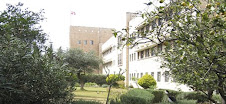'Tantur' simply means 'Hill Top'. From our meeting room we look down at the checkpoint and the wall that separates Bethlehem from Jerusalem, and over the wall to Bethlehem.
This morning we set off by coach through the checkpoint and through Bethlehem into the West Bank. Driving along a road designated for Jewish settlers in the west bank we went up to the 'Herodion', the summer palace built by Herod. In a commanding position at the hill top palace had commanding views over the Judaean wilderness to the Dead Sea, glinting in the distance.
Beyond were the hazy Moabite hills.
There was something imposing, powerful and disturbing about the palace. It was a statement of power. Built by the Herod who had re-built the second temple and had been responsible for the slaying of the innocents, it had been the base for the Bar Kochba revolt in the second century AD.
Just below the palace was an Israeli army outpost, and beyond two settlements.
We returned to Bethelehem and the Shepherds fields. The site of a monastery going back to the very beginnings of the monastic movement in the 4th century, it was moving to sit in the kind of cave that might have been used by shepherds looking after their sheep and read the account of the shepherds from Luke 2 and then to sing Silent night.
From the Shepherds fields we made our way to Manger Square and the church of the nativity. Again, I had major problems with 'location'. Does it really matter? Michael McGarry suggested that as Hadrian had located a temple on the spot Helen, iConstantine's mother, later identified as the place of the nativity it was quite likely.
I did not go down into the grotto, but instead went into a neighbouring church and another cave. It was quite moving. It was associated with Jerome's translation of the Bible. The white clad walls, and the limestone rock with all its layers, made caves exactly what you would expect. They were the kind of caves that could easily have been used in the way the bible describes. Strange and yet strangely moving.
After Manger Square we made our way through the busy, narrow alleys, up the hill to the Lutheran centre, a wonderful new building with a very impressive design that was host to a Lutheran church community serving the communtiy in Bethlehem.
The Rev Dr Dimitri Rahab, a Palestinian Lutheran Pastor, spoke to us of his vision for church work in Bethelehm. He felt very much called to a ministry of preaching the good news that so needs to be heard, of teaching and of healing. He spoke of the very significant work of social service that church is carrying out. He made five observations:
1) This is a very biblical time and place ... as in the time of Jeremiah too many people talk the language of peace without living a life of peace. There is a call, he suggested, to work for peace with justice.
2) There's too much politics - instead of working 'up there' in the higher echelons of 'politics' it was more important to work on the ground, caring for the society and making a difference there.
3) There's too much religion - and a need for more sprituality and prayer.
4) There's too much humanitarian aid - and not enough work aimed at development
5) There's too much 'pess-optimism'. Optimistic one day. Pessimistic the next. There should instead be hope that takes seriously the present situation, where Dimitri Rahab saw little change for two generations, and at the same time works for the good that will come in the future. Hope sees what's going on and still plants olive trees.
Our session came to an end and we left for lunch, while a group of German parliamentarians followed us to be addressed by the same Pastor. It is wonderful to see the way inwhich we are treated to such high powered speakers.
Lunch over, we walked through the streets of Bethlehem to the Wiam centre for reconciliation and an equally inspiring address by Zoughbi Zoughbi, who last year came over to Britain with the Fellowship of Reconciliation on a speaking tour.
He spoke of the need for the work of reconciliation to be done at the local level, bringing healing where rifts were caused often as a result of the conflict. Again, most moving.
Walking back towards Tantur instead of taking the bus, we headed for Rachel's tomb only to find it's inaccessible from Bethlehem and the other side of the wall. A visit to a Palestinian exhibition centre included an unexpected meeting with a family whose story I will tell later.
The walk back took us through the check point on foot. A menacing experience and that was just for us.
AFter prayers and our evening meal we had another high powered lecture this time from Deborah Wiseman, an Orthodox Jew. She refused the epithet moderate and spoke of her passion for her religion, but eqully of her commitment to a tolerance that was tolerant of the other, a pluralism that could see other people believed differently, and an openness that was prepared to learn from others. AFter the two earlier speakers of the day we were offered another view of the very same barrier: this time while opposing the occupation of the West Bank and the settlements, Debborah Wiseman advocated a state for Israel and a state for the Palestinians but could see the value of the security wall. She spoke of her passionate commitment to human rights and to change.
Another moving and troubling day came to an end, with answers to questions as elusive as ever. But at the same time a very real sense of the vital importance of coming alongside people, seeking understanding and seeking to make a difference.
Thursday, April 3, 2008
Subscribe to:
Post Comments (Atom)

%2BChurch.jpg)







No comments:
Post a Comment